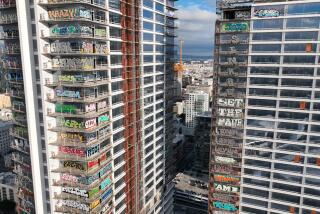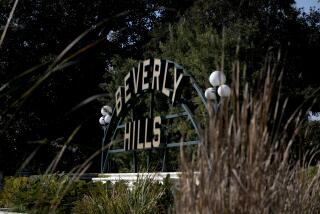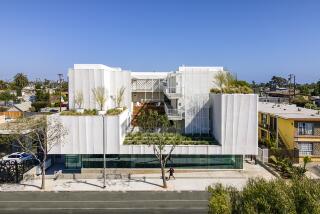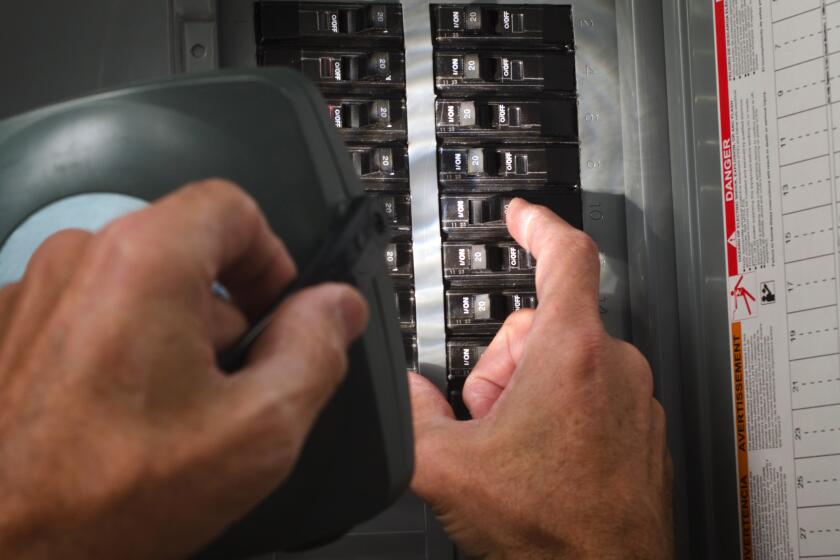South L.A. slated to get its first high-rise tower. But residents are divided, fear gentrification
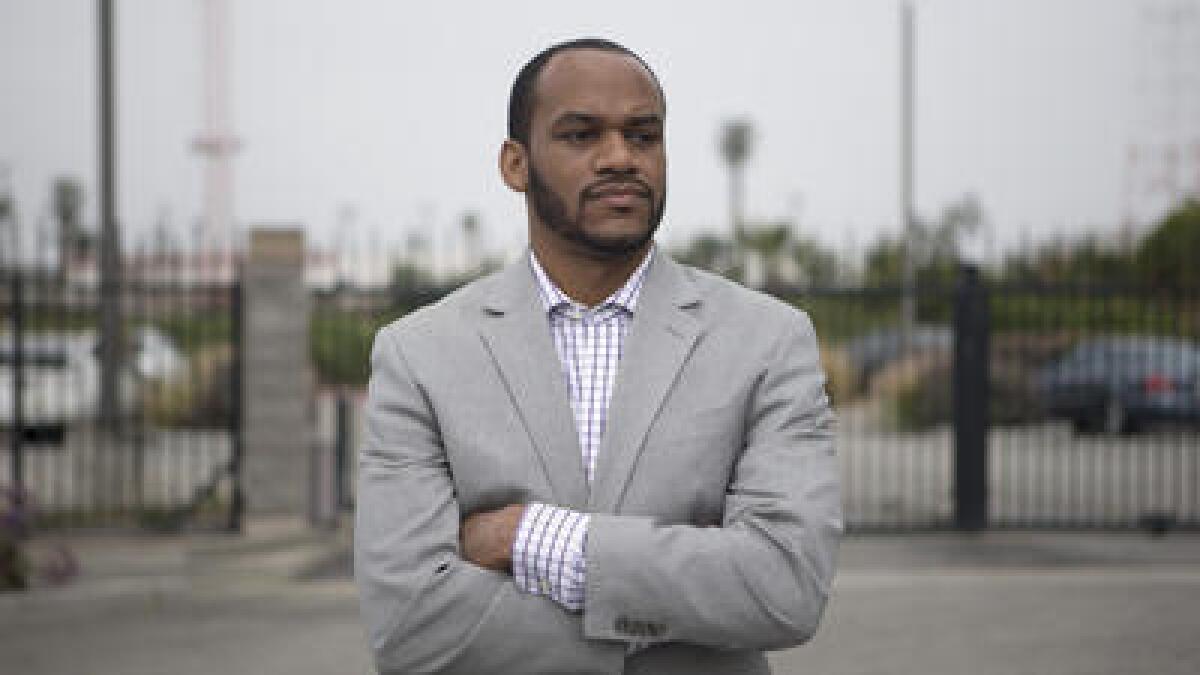
Signs of gentrification have been popping up in Los Angeles neighborhoods south of the Santa Monica Freeway for several years now.
But what developers want to do at the intersection of La Cienega and Jefferson boulevards would be dramatic even by the standards of the development boom hitting the city.
There, next to an Expo Line station, they want to build a 30-story tower complex that would include upscale apartments, some with floor-to-ceiling views of the Pacific Ocean, Hollywood and downtown L.A., along amenities residents have yearned for: a supermarket, sit-down restaurants and open green space.
Some residents relish the idea of a glittering tower rising from an area of Southwest L.A. that until recently was marked by warehouses, radio transmission towers and strip shopping malls – a sign that their neighborhood has finally arrived.
“To have a developer willing to come in … I think it’s fantastic,” said resident Denise Edwards, 66. “If it raises our property value, great. Hallelujah.”
But others see the project as a bad news for residents who live there now. They fear the upscale development will bring in residents who have been priced out of Culver City, Venice and the Miracle Mile areas, causing rents to rise and pushing out people of modest means.
The project has sparked a legal battle as well as a debate about the direction of the neighborhood.
The area is a crossroads of sorts, not far from the trendy shopping districts of Culver City to the west and the upscale Baldwin Hills neighborhood to the south. But in the flatlands, there are blocks of modest apartments and small homes. City planners have been trying to locate more dense development next to rail lines, and the La Cienega station would seem to be a strong candidate because of its central location and proximity to Los Angeles International Airport.
In a lawsuit filed last month, the Crenshaw Subway Coalition and Friends of the Neighborhood Integrity Initiative say city officials violated state and local laws when it approved the project. The City Council amended zoning and height restrictions to permit the high-rise.
Op-Ed: Why is L.A. too pricey? Blame low vacancy rates, not luxury high-rises »
Opponents said the tower would be too tall and the housing complex too dense for the area. Additionally, they said the massive development would further congest major streets, which are popular routes to LAX.
“We are in areas where we have been frequently deprived of these services,” said Damien Goodmon, head of the Crenshaw Subway Coalition. “We want them, but you can’t tell us to get that we have to put up with out-of-scale, out-of-character development that is going to overburden our area and not even be affordable for us.”
City officials would not comment on the lawsuit, but said that there has been overwhelming support for the project. During the two-year approval process and multiple meetings, hundreds of residents said they backed it, said Vanessa Rodriguez, a spokeswoman for L.A. City Councilman Herb Wesson, who represents the area where the project is slated to be built.
“It’s unfortunate that the only concerns about this project are coming from outside of the community,” she said. Residents’ input was “instrumental in creating the vision for the project. This is about having community members shop in the community they live in and bringing new amenities to the neighborhood.”
It’s unfortunate that the only concerns about this project are coming from outside of the community.
— Vanessa Rodriguez, spokeswoman for Councilman Herb Wesson
The lawsuit was filed by Crenshaw Subway Coalition, a group of residents, property owners and merchants in South L.A. But the joint petitioner is Friends of the Neighborhood Integrity Initiative, part of Coalition to Preserve LA, a nonprofit organization backed by the Hollywood-based AIDS Healthcare Foundation, which aims to put a measure on the March ballot to crack down on L.A. real estate “mega development.”
The project, known as Cumulus, will sit on the former 11-acre broadcasting facility of radio stations KABC and KLOS at the foot of Baldwin Hills. San Francisco real estate developer Carmel Partners, under the umbrella CP V Cumulus LLC, plans to build a nearly 2-million-square-foot development. It will include 1,218 homes, up to 200,000 square feet of office space and 100,000 square feet of grocery, restaurant and retail space. Fifty-five of the apartments will be set aside for people earning 80% to 120% of the average median income. Developers said the project would create more than 1,700 full-time jobs during construction and up to 1,200 full-time, ongoing jobs.
Renderings show a walkable village steps from the rail line. A park would be next to outdoor dining space.
But Goodmon said the market-rate rents would be out of reach for those now living in the area.
“This project ain’t for us,” he said. “There will be many renters around the area who are going to be indirectly displaced because the value of the land is going to go way up because you impose this many market rate units on an environment.”
Local leaders said the development is the kind of project they envisioned along transit lines that can spur economic growth in areas long ignored by private developers. Billions of public funds have been poured into building the Expo Line and the Crenshaw Line to LAX. Both rail lines cut through South L.A., which has seen had a tough time attracting quality projects since the 1992 L.A. riots.
Edwards, president of the Baldwin Hills Village Garden Homeowner Assn., said she welcomes the development. The developers attended three board meetings to solicit residents’ feedback. They took note of concerns, which included issues with the monolithic, concrete wall design; reflective exterior material; and the need for sit-down eateries. She said the developers came back to the meetings with solutions and brought the owner of a restaurant looking to open a South L.A. location.
See more of our top stories on Facebook »
Edwards and other residents in the 444-property association said they were pleased with the solutions presented and believe the process was fair.
She said the neighborhood took a big hit after the 1992 riots and that property values have not bounced back in the way they have in other parts of the city. She hopes a major high-rise development in the area would mark a milestone and help generate more interest.
“We have been red-lined,” Edwards said. “We have been devalued where you can’t get high-end [stores] and restaurants to come to this community.”
About 80 residents living east of the development organized under the La Cienega Heights Homeowners Assn. to voice their concerns over traffic. They hired the Channel Law Group, which specializes in environmental and land use issues, and brought in a traffic expert. But they ultimately supported the project.
Last week, the developers agreed to fund mitigation measure to alleviate traffic concerns including creating a cul-de-sac to prevent travelers from cutting through their neighborhood, relocating a bus stop on Jefferson, upgrading a crosswalk to make it safer and creating permitted parking so that visitors to the proposed building can’t park in their neighborhoods.
But in their lawsuit, opponents say the dimensions of the building being proposed contradict what was outlined in a recently approved blueprint, the West Adams-Baldwin Hills-Leimert Community Plan.
In it, residents and the Planning Department agreed that the maximum height for the building surrounding the project would be 75 feet, or 6 stories. Later, city officials voted to extend the height limitation.
“It’s built and designed like a fortress against the community with 10-story tall buildings all around it and the vast majority of them not for use by local people,” said Jill Stewart, campaign director of Coalition to Preserve LA.
Clint Simmons, a member of the Crenshaw Subway Coalition and West Adams resident, said he worries the skyscraper would open the door for other high-rise buildings.
“I’m not opposed to development,” Simmons said. “We can have a grocery store and sit-down restaurants without a skyscraper.”
For more California news, follow @AngelJennings. She can also be reached at angel.jennings@latimes.com.
For more California news, follow @AngelJennings. She can also be reached at angel.jennings@latimes.com.
ALSO
Beaumont, stunned by years of alleged corruption, has been ‘turned upside down’
Dredging likely to wipe away Orange County ‘dog beach,’ at least for a while
Proponents planning a redo of stalled water-train initiative
More to Read
Sign up for Essential California
The most important California stories and recommendations in your inbox every morning.
You may occasionally receive promotional content from the Los Angeles Times.
